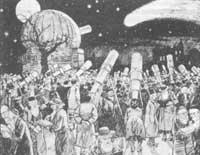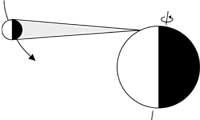Also animals astronomers?
1993/08/01 Arregi Bengoa, Jesus Iturria: Elhuyar aldizkaria
On this occasion we will talk about a topic related in a transversal way to astronomy. Taking as reference the bodies and celestial phenomena, we will mention the functions of some animals, and especially migrations.
We will begin with nautical ones that relate their regenerative function to the phases of the Moon, which are well known. Thus, for example, in Bermuda and other islands of the Antilles this process of regeneration can be observed year after year, since it occurs with great precision three days before sunset between 29 June and 28 July. But perhaps another kind of similar worm is better known in the seas: the so-called “moon worm” or “stick.” These shows take place on the seventh day after the full moon of October and November. Suddenly, they emerge on the surface of the sea covering an extensive region. Then the sticks lay their green eggs, and their yellow sperm. In addition to the show, these diners offer a good dish that they taste to taste.

However, the most abundant and prominent examples of aniamlis with “famous astronomers” can be migratory birds. There are many species that after spending the summer in the north of our hemisphere, head south for winter, sometimes exceeding 5,000 or more kilometers on the sea. For next summer they return to the same place of origin, of course. Stars are the only reference with which they focus on travel. T. The bird Passerina cyanea, studied by the zoologist of Emlen, is a clear example. After spending the summer in North America, in autumn, flying at night, this bird travels to Central America on a journey of about 3,200 km.
T. Analysis of these birds Emlen designed a special cage so that the bird, without seeing anything from the earth, could see only the sky and, on the other hand, wanted to act to know the direction of the flights. To achieve these objectives he used a cage in the form of a cone trunk, leaving at the top the largest base with a transparent cover (for the bird to see the sky). On the other hand, to achieve the second objective, the pavement was made with a cloth impregnated with ink and walls with absorbent white paper. The bird left traces on the paper every time it jumped to fly.
The results obtained with this structure are very clear. During the nights of April and May, the birds tried to move north. During the months of September and October, on the contrary, their intention was shown to the south. In drawings a) and b) of the image appear in black the traces left by the bird on absorbent paper. If at that time the sky is cloudy or the bird cannot see the kneading because the cage is covered, it jumps anywhere, as can be seen in drawing c) of the figure.
These results, however, do not tell us which stars serve to guide us. As is known, in the sky you can see throughout the year, we have circumpolar stars that change with the seasons. Some of those that appear in spring or autumn or are circumpolar (especially polar) those that use birds? T. to decide this problem Emlen replaced the transparent cage cover with a planetarium. This allowed to place the polar star in different directions, always obtaining the same results: the polar star delimited where the footprints appeared.
Therefore, the polar star is known by Passerina{ and it takes as reference to travel to the North and South. A change in the planetarium also solved another problem. To know if the bird finds the polar star knowing the constellations around it or if the other star knows it because it revolves around it, T. Emlen turned the planetarium around Betelgeuse. This trick only deceived the younger birds. Therefore, the older ones, as they have experience, take into account not only the turn, but also the appearance of the constellations.
But it is still another important point that we have not highlighted: how do birds decide when it is time to travel and whether they have to go north or south? To answer this question there was no change in the cage. By providing adequate food and controlling the number of hours of exposure to light, birds may change their physiological state and at any time of year appear what they would have in spring or autumn, such as accumulated fat, the color of the pen, etc. The reaction of the birds of the Passerina cyanea was always the same: whenever the physiological conditions were those that had in the form of travel, he began to try to undertake the journey, in a direction appropriate to the conditions. Therefore, the physiological conditions are those that limit the travel and direction of the same, and not the kneading height of the polar star.
To put an end to the peculiarities of this species, it must be said that the birds return to the same place in which it was the previous year, taking advantage of the position of the sunset Sun, the direction of the winds, the magnetic field of the Earth, etc.
The case analyzed is not the only one, of course, and birds are not the only animals that use celestial stars to orient themselves in their travels. Some desert ants, for example, guide the Sun's journey through the sky. Other butterflies have a certain inner compass that takes advantage of the Earth's magnetic field. On the other hand, other fish, spiders and monkeys have also somehow known the stars of the sky.
February 2015 SUN: July 22 at 19h 50min (UT) enters the constellation of Leo.
PLANETS MERCURY: it will be very difficult to see during this month. Just in case, we can try it in the last three or four days. |
SUN: August 23 at 2h 5min (UT) enters Virgo.
PLANETS MERCURY: Reaches its maximum elongation West on day 4 (19º). We will have the opportunity to try to see her in the morning around that day. |

Gai honi buruzko eduki gehiago
Elhuyarrek garatutako teknologia





